Features
As Oxford’s new academic year gets underway, we take a closer look at an award-winning teaching module that brings students face-to-face with real-world high-stakes decisions.
What would you do if there was a sudden nuclear threat from North Korea and you were responsible for deciding how your country responded? At Oxford University’s Blavatnik School of Government, Master of Public Policy (MPP) students tackle this challenge head-on in the 'North Korea Crisis Simulation' – an immersive teaching module that represents an innovative approach to teaching public policy.
The one-year postgraduate degree is designed to equip future leaders with practical skills for public policy practice. Its students come from around the world – last year hailing from 58 different countries and diverse backgrounds such as government, NGOs, journalism and academia.
The simulation, which was recognised earlier this year by the Vice-Chancellor’s ‘Innovative Teaching and Assessment’ Award, plunges the MPP students into a complex economic, political, and military crisis on the Korean peninsula; testing their ability to make high-stakes decisions, balance national priorities, manage security concerns, and collaborate with international partners under extreme pressure – all within a world marked by interconnected crises and rising geopolitical competition.
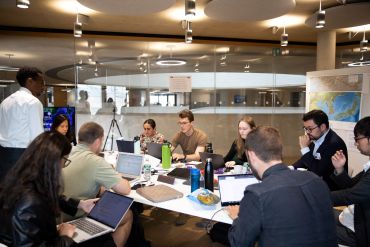 Students assigned to the DPRK (North Korea) room developing strategy
Students assigned to the DPRK (North Korea) room developing strategyThe simulation is the brainchild of Professor Tom Simpson, who has first-hand experience of complex military situations, having served as an officer with the Royal Marine Commandos for five years. It incorporates elements of a ‘war game’, imitating a geopolitical crisis scenario where participants’ actions impact the options available to others.
This simulation challenges students to integrate theoretical knowledge with practical skills, pushing them to perform under high-stakes conditions.
It provides a deeply immersive experience that evolves based on their decisions, enhancing their understanding of national power dynamics. So our students are gaining invaluable insights into real-world policymaking and developing skills directly applicable to their future careers.
Professor Tom Simpson, Blavatnik School of Government
Split into six teams or countries – USA, China, Japan, Russia, South Korea, and North Korea – the students operate from meticulously designed ‘situation rooms’ complete with national flags, authentic snacks, and tailored props such as national seals on stationery, badges, and door plaques, as well as portraits of national leaders. The rooms are equipped with a bespoke communications suite, giving students the ability to receive recordings and live broadcasts from the dedicated Green Room.
In the weeks leading up to the simulation, MPP students receive detailed background briefings and in-depth reading assignments and research into the history of the crisis, the political, economic, and cultural characteristics of the countries in the region, and the national interests of the six countries involved. But it’s not until 24 hours before the exercise itself begins, when they are presented with confidential instructions, that they learn what their individual roles in the simulation will be. And then, at the start of the simulation, they finally learn about the crisis that is unfolding.
Aoife, a student from Northern Ireland who was assigned the role of the Chief of Staff to the President of the USA said: ‘I got to be a decision-maker at the epicentre of the simulation, which taught me a lot about teamwork, how to handle pressure, and the importance of maintaining focus on your ultimate goal.’
She also reflected on the challenges of working collaboratively in such a pressured environment: ‘It was really eye-opening to be thrown into a scenario where you have only limited information, there’s mistrust across teams, but the stakes are so high that you know you have to find a way of working together.’
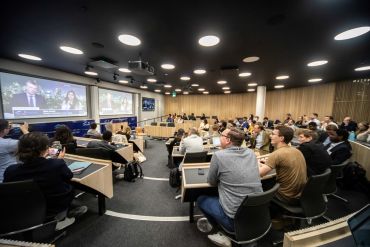 Students participating in the breaking news broadcast that concludes the simulation
Students participating in the breaking news broadcast that concludes the simulationWhile fictional, events in the simulation closely resemble real-world occurrences, such as the abduction of Japanese citizens by North Korea, financial turbulence, and gunfire in the Demilitarised Zone, to emphasise the complexities of real-world decision-making.
Erik, a Ukrainian MPP student, reflected: ‘The most valuable lessons were about teamwork under immense time pressure and responsibility; organising team efforts, balancing each member's involvement with the need to make quick decisions, effectively delegating tasks, and strategic action planning. I learned the importance of being ready to pursue moderate goals, as aiming for maximalist objectives can lead to counterproductive results.’
The award-winning ‘North Korea Crisis Simulation’ is one example of an immersive teaching method that has long been championed by the Blavatnik School’s Case Centre on Public Leadership, which develops teaching materials for public leaders at all career stages, thrusting them into the heart of a range of crises and challenges around the globe. The North Korea Crisis Simulation module has been made freely available for other schools of public policy to download here.
 Professor Mark Graham
Professor Mark GrahamWithout data annotators creating datasets that can teach AI the difference between a traffic light and a street sign, autonomous vehicles would not be allowed on our roads. And without workers training machine learning algorithms, we would not have AI tools such as ChatGPT.
Professor Mark Graham researches global technology through the eyes of the hidden human workforce who produce it. He argues that AI is an "extraction machine", churning through ever-larger datasets and feeding off humanity’s labour and collective intelligence to power its algorithms.
We caught up with Mark to discuss some of these issues.
In talking about the AI technologies we rely on, you mention the "countless humans forced to work like robots, toiling in monotonous low-paid jobs just to make such remarkable machines possible" -- who are these people, and what sorts of jobs are they doing?
There is a whole range of ‘data work’ needed to make our digital lives possible. Data annotators label data with tags so that it can be understood by computer programs. Content moderators sift through digital content in order to remove harmful content that breaches company guidelines. If you have ever interacted with any form of AI, whether it be a chatbot, a search engine, a social media feed, a streaming recommendation system, or a facial recognition system, data workers have had a hand in building or maintaining those systems.
The root cause of the problems encountered by data workers lies in the power imbalance between them and the institutions that govern their jobs… It is unlikely that any of the issues data workers experience will ever be meaningfully addressed without workers building their collective power in movements and institutions.
You talk about "building worker power", as a step towards redressing some of the issues of the hidden labour of AI — I guess this is quite difficult when these jobs are so atomised, and the workforce so expendable?
The root cause of the problems encountered by data workers lies in the power imbalance between them and the institutions that govern their jobs. Historically, when social movements achieve lasting change, it's often through organizing a critical mass of people to push for policies that address systemic inequalities. It is therefore unlikely that any of the issues data workers experience will ever be meaningfully addressed without workers building their collective power in movements and institutions.
However, data workers face serious barriers to ever building that power. The jobs that they undertake are relatively footloose and standardised, and, as a result, are carried out in a planetary-scale labour market. Their jobs can be quickly shifted to the other side of the planet.
There are no easy ways for workers to build collective power under these sorts of conditions. Data workers in a country like Kenya or the Philippines have an enormous structural disadvantage. However, that is not to say that organizing is impossible. In production networks that are organised globally, workers will increasingly also need to explore ways of organising across geographies. This will undoubtedly take a range of forms, but will all need to be rooted in the principle that workers acting collectively will be able to demand better conditions for everyone in a production network. Isolated efforts, by contrast, are unlikely to achieve lasting change.
A requirement of accountability is visibility. What are some of the ways that this labour is hidden from us -- and why? How could it be made more open and visible, more recognised?
The labour in AI production networks is almost always hidden from view. If you drink a cup of coffee or buy a pair of shoes, you probably have a conception that at some point that coffee passed through the hands of a plantation worker or the shoes were assembled by someone in a sweatshop. However, precisely because AI presents itself as automated, very few people can imagine what the human labour on the other side of the screen looks like. AI companies are complicit in this subterfuge. They want to present themselves as technological innovators rather than as the firms behind vast digital sweatshops.
Because AI presents itself as automated, very few people can imagine what the human labour on the other side of the screen looks like. AI companies are complicit in this subterfuge.
Because of this enormous gap between how tech companies present themselves and the actual on-the-ground conditions experienced by workers in those production networks, I started the Fairwork project. Fairwork evaluates companies against principles of decent work and gives every company a score out of 10 based on how well they stack up against those principles. To date, we have scored almost 700 companies in 38 countries. Doing this work has encouraged a lot of companies to make improvements to the working conditions of their workers to receive a higher score.
The next phase of our project will involve going to the lead firms in AI production networks, the brands that consumers are familiar with, and letting them know that we are going to start holding them accountable for all the working conditions upstream in their production networks. We will constructively work with them to embed principles of fair work into their contracts and supplier agreements, but also use our research to hold them accountable when they fail to do so.
Watch Mark’s latest video highlighting the hidden cost of AI and the implications of this ever-evolving technology for the thousands of AI workers toiling away behind the scenes to deliver AI powered services.
I guess an obvious solution to some of these issues is regulation -- workers should be protected in whatever jurisdiction they are working, and wherever in the production chain they sit. What efforts are being made in this area?
The planetary labour market that much of this work is traded in makes it difficult for regulators in the Global South to raise conditions. If regulation raises costs in Kenya, those jobs can move to India. If regulation in India raises costs, those jobs can move to the Philippines. These dynamics create a ‘race to the bottom’ in wages and working conditions, leaving regulators having to choose between bad jobs or no jobs. As the economist Joan Robinson famously said, ‘The misery of being exploited by capitalists is nothing compared to the misery of not being exploited at all.'
However, even though the global geography of the labour market neuters the ability of regulators to act in the Global South, it strengthens the hand of regulators in the Global North. Regulators in countries that are home to a lot of the demand for digital products and services have the ability to play an outsized role in setting standards. The EU's proposed Supply Chain Directive is a good example of this. It aims to make companies operating in the EU accountable for human rights and environmental impacts throughout their global supply chains. Because few AI companies will want to forgo being able to sell to consumers in the EU, this directive has the potential to improve conditions for the many workers in countries with weak labour protections.
Much of the discussion about AI has been focused on existential risks that it might present in the medium- to long-term future. However, the real risks of AI are already right here in the present.
Finally, your assessment of the AI industry is pretty bleak, that "workers are treated as little more than the fuel needed to keep the machine running" — and that this is happening to all of us, right now. What are some of the key issues and battlegrounds in which this question will be played out in the coming years?
Much of the discussion about AI has been focused on existential risks that it might present in the medium- to long-term future. However, the real risks of AI are already right here in the present.
A few decades ago, anti-sweatshop campaigns shifted attention to the plight of garment workers, and shifted the onus of responsibility for those workers onto the brands who sell clothes. Those campaigns did not fully eradicate sweatshops, but have been an important moment on a path to normalising the idea that lead firms in production networks have the potential power to impose decent work conditions throughout a supply chain. If we are to head towards a fairer future of work, one of the key battlegrounds will have to be ensuring that big tech companies take responsibility for the conditions of all workers in their supply chains.
Because tech companies have, to date, taken on very little of this responsibility, pressure will be required from consumers, policy makers, and workers. Consumers will have to recognise that they are complicit in the conditions of workers who made or maintained the product or service that they are using. Policy makers will have to realise that a laissez-faire approach to regulation is only serving to increase inequalities. And workers will have to find ever more creative ways to organise across supply chains in order to hold companies accountable. Until we all force these companies to change, we will only continue to be nothing more than fuel for the machine.
***
Professor Mark Graham was talking to the OII's Scientific Writer, David Sutcliffe.
Mark Graham is Professor of Internet Geography at the Oxford Internet Institute, where he leads a range of research projects spanning topics between digital labour, the gig economy, internet geographies, and ICTs and development. He's also the Prinicipal Investigator of the participatory action research project Fairwork, which aims to set minimum fair work standards for the gig economy.
Read his latest book: James Muldoon, Mark Graham, and Callum Cant (2024) Feeding the Machine. Canongate.
Astrophoria’s Programme Director, Dr Jo Begbie, speaks about the programme’s first year and shares her highlights.
As the end of the academic year fast approaches, twenty-two students from across the UK will soon be completing the University’s first Astrophoria Foundation Year. Providing a one-year fully funded course for UK state school students who have experienced severe personal disadvantage or disruption to their education, the Astrophoria programme is designed to enable motivated students to reach their academic potential by bridging the gap between A-Levels and Oxford’s challenging undergraduate degrees.
It is led by Dr Jo Begbie, who has had plenty of experience of educational environments prior to arriving in Oxford in 2004: completing her undergraduate degree at Leeds, a PhD at UCL, and postdoctoral research at King’s College, London. At Oxford, Jo started a research lab and took up the post of lecturer in Medicine, before becoming a Tutor in Medicine at one of Oxford’s colleges, Lady Margaret Hall.
 Students meet Oxford's Vice-Chancellor, Professor Irene Tracey and Astrophoria Director, Jo Begbie, during their orientation week
Students meet Oxford's Vice-Chancellor, Professor Irene Tracey and Astrophoria Director, Jo Begbie, during their orientation week“And then as a medicine tutor doing admissions, I could see that there were students that had potential but weren’t going to get the grades to come into Oxford, and often they were young people from less advantaged backgrounds – Astrophoria is about putting those two things together.”
Foundation Years can mean different things for different institutions, says Jo. At Oxford, the Astrophoria programme – which follows on from a college-based initiative Jo was involved in at Lady Margaret Hall – provides lower contextualised offers for entry to study. But importantly, according to Jo, “rather than lowering grades for undergraduate study and expecting them to cope”, it gives the students a year of support, both academic and personal (there is a dedicated welfare role in the team), before they join the undergraduate student body.
Over the course of the academic year, students not only receive teaching in their chosen subject (in Humanities, Law, PPE, or CEMS (Chemistry, Engineering, and Material Science) ), they also undertake a Preparation for Undergraduate Studies course. “It’s thinking about what academic skills they might require and recognising they may need support in order to thrive on an undergraduate course,” Jo says, “but also helping them build that sense of belonging in an academic institution like Oxford, which has its own nuances and distinct learning environment and can be quite a big step for some students.”
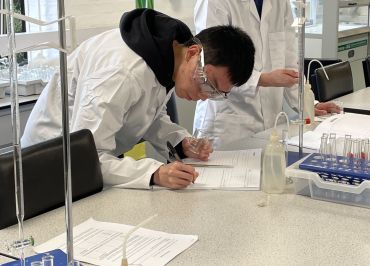 Chemistry student Yihao during his first term as an Astrophoria student at Oxford
Chemistry student Yihao during his first term as an Astrophoria student at OxfordThe first Astrophoria students arrived last September for their Orientation Week, which, Jo says, was “really important for building that sense of belonging and starting to do some critical thinking, but in a slightly more playful way. It’s quite deliberately set up to get them to be engaged in asking questions and starting to build their confidence.”
The students are based across 9 Oxford colleges, coming together for different aspects of the course and events. So how well have the cohort integrated into the wider student body? “We were a bit nervous about that” says Jo, “but, it hasn’t been an issue – they’ve been embraced by their colleges and just treated like any other student”.
A dedicated Outreach Officer in Jo’s team visits schools to build awareness of the Astrophoria programme among teachers and students. The reaction is overwhelmingly positive: “There’s quite often – more from the teachers – ‘oh, this really is as good as it sounds’”.
The team are focused on ensuring that eligible applicants feel motivated to apply. “There are still some students who think that Oxford’s not going to be for them, but it’s nice to begin to build our cohort of students who’ve been through the programme, to be able to use their voices to go back to schools so that they can try and dispel some myths about who Oxford is for.”
 Astrophoria students speak about their experiences at an event in Oxford
Astrophoria students speak about their experiences at an event in OxfordReflecting on the programme’s inaugural year, Jo’s personal highlights come from the students and how they’ve developed, which she has seen first-hand through teaching as part of the Preparation for Undergraduate Study courses. “Some students in the first term are very nervous, very shy, very unsure and they’ve just grown in confidence and engagement in talking about things.”
A recent assessment in which the students presented posters addressing an academic question was a particular high point: “For me, the energy just really summed up the Astrophoria year. There were 22 students talking animatedly about an academic topic they were interested in, and they were energised but also supportive of each other and explaining their work to one another. Essentially that’s what we’ve been trying to build – we talk about a community and support network, an excitement in the academic work that they’re doing, and a willingness to present things."
Another ‘proud mum’ moment, as she calls them, came at an event with the Astrophoria donor. “Two of the students gave speeches and you just felt ‘wow’. They'd only been here a term but were happy to stand up and speak at an event”.
Have there been any surprises this year? Nothing major, she says, but “dealing with 22 young people there’s always something!”. Inevitably, says Jo, the programme will evolve as lessons are learnt, and the goal is to steadily increase the number of Astrophoria students over the next few years. Some of this year’s cohort may not progress on to Oxford’s undergraduate courses, but Jo hopes they have all benefitted from the programme and their Oxford experience; “I want the students to feel empowered”, she says.
Find out more about the Astrophoria Foundation Year.
On World Malaria Day 2023, the global fight against malaria has hit a critical point in Africa. Recent studies have confirmed that malaria parasites resistant to artemisinin have emerged in Rwanda, Uganda and the Horn of Africa.
Artemisinin-based combination therapies (ACTs) are the first line treatment for malaria and there is no immediate replacement available. The loss of ACTs will put millions of Africans, mostly children under the age of 5, at risk of drug-resistant malaria infection and death.
One possible solution?
Adding a third drug to current ACT drug combinations. These Triple ACTs or TACTs have been found in clinical trials in Asia to be highly efficacious even in places where ACTs were failing.
'It is so much easier to prevent antimalarial drug resistance than to try and contain it. We are in danger losing of our current antimalarial drugs to resistance,' said Professor Sir Nick White, University of Oxford Professor of Tropical Medicine based at the Mahidol-Oxford Tropical Medicine Research Unit (MORU), in Bangkok.
'Triple artemisinin combination treatments [TACTs] will protect against resistance and help ensure that these drugs remain effective until new drugs arrive in 5-10 years time,' said Professor White.
Before TACTs can be widely deployed in Africa, however, their efficacy, safety and tolerability must be confirmed in African populations, especially children.
To that end, the Development of Triple Artemisinin-based Combination Therapies (DeTACT) trial is studying in eight African and two Asian countries two new TACTs - Artemether+lumefantrine+amodiaquine and Artesunate+piperaquine+mefloquine - to generate evidence that they are safe and effective malaria therapies.
The DeTACT project has also conducted modelling, ethics and market positioning studies to support their use in Africa and thereby prevent or delay the emergence of artemisinin and multi-drug resistant malaria.
'The DeTACT project aims to provide the necessary evidence that TACTs can both delay antimalarial drug resistance to existing drugs, and be an effective treatment for multidrug resistant infections. DeTACT will also deliver a product to market, and engage with national and global policy makers and stakeholders to discuss the potential position of TACTs in the mix of antimalarial drugs,' said University of Oxford Professor Arjen Dondorp, DeTACT project Principal Investigator.
Led by University of Oxford-affiliated researchers based at MORU in Bangkok, and funded by UK Aid administered through the Foreign, Commonwealth and Development Office (FCDO), the DeTACT trial has recruited over ~1800 patients as of April 2023 , with recruitment and follow-up completed in Niger and Nigeria, and no major or unexpected safety signals detected.
Once recruitment and follow-up are completed at the end of 2023, DeTACT investigators will present results in April 2024. Prior to that, they aim to present interim findings at a DeTACT symposium in October 2023 at the American Society of Tropical Medicine and Hygiene (ASTMH) 72nd Annual Meeting in Chicago, USA.
The first modelling study to project the impact of TACTs in preventing or delaying artemisinin resistance, led by Associate Professor Ricardo Aguas, University of Oxford, and Associate Professor Maciej Boni, Pennsylvania State University, has been completed and will soon be published in the prestigious journal, Nature Communications.
'These DeTACT modelling studies and market positioning studies generate data that will be crucial in our efforts to effectively introduce TACTS and to project the impact and cost-effectiveness of TACTs in preventing the spread of artemisinin resistance. Along with the clinical trial, these studies constitute a comprehensive assessment of the expected advantages and potential barriers to the large-scale use of TACTs,' explained Dr Chanaki Amaratunga, DeTACT Project Coordinator.
The DeTACT project has engaged malaria stakeholder engagement officers to communicate directly with National Malaria Control Programmes (NMCPs) to present to them to the DeTACT project and TACTs in general. Presentations on DeTACT and TACTs have been made at the RBM Partnership to End Malaria Case Management Working Group and the Seasonal Malaria Chemoprevention (SMC) Alliance Annual meetings. These efforts have led to significant interest from all parties in participating in future research and exploring the roll-out of TACTs in their countries.
To make TACTs available as quickly as possible where they are most needed it is critical to work with the pharmaceutical industry on the co-formulation. MORU has signed a memorandum of understanding with Fosun Pharma, China, and the Medicines for Malaria Venture (MMV) to develop and pre-qualify fixed-dose combinations of artemether-lumefantrine-amodiaquine, prior to deploying them across Africa.
'The DeTACT trial will generate data not only on the efficacy and safety of TACTs but also on the pharmacokinetics of each of the drug components, including in malnourished children – a particularly vulnerable sub-population. In addition, there will be cutting-edge analyses, combining clinical trial data with that from whole genome and transcriptome studies, to improve our understanding of artemisinin and antimalarial drug resistance,' said Dr Mehul Dhorda, DeTACT-Africa Coordinator.
Further reading
Market Formation in a Global Health Transition.
Triple Artemisinin-Based Combination Therapies for Malaria - A New Paradigm?
Professor Chrystalina Antoniades of the Nuffield Department of Clinical Neurosciences explains how the COVID pandemic accelerated an innovation in one research project into Parkinson's Disease.
Parkinson’s is a progressive neurological condition, which affects around 145,000 people in the UK.
Symptoms start to appear when there isn’t enough of the chemical dopamine in the brain to control movement properly. People with Parkinson’s don’t have enough dopamine because some of the nerve cells that make it have died.
There are lots of symptoms, but the three main ones are tremor (shaking), slowness of movement, and rigidity (muscle stiffness).
Doctors typically diagnose and monitor the progression of Parkinson’s by assessing these symptoms using a ‘clinical rating scale’. This relies solely on the clinician’s own subjective impression of the person’s condition.
Since 2016, the NeuroMetrology Lab at the University of Oxford has been developing objective numerical measures to help doctors accurately diagnose disease and monitor the progression of Parkinson’s – which could lead to the provision of more targeted and timely treatment. Until recently this research team, based in the Nuffield Department of Clinical Neurosciences, has been carrying out their research via in-person clinics, attended by patients four times a year.
During the patient’s two-hour clinic visit, the researchers would measure subtle abnormalities in the speed and coordination of fast eye movements (known as saccades), hand movements, and gait. They would also assess cognitive performance using tasks on a tablet. Then they would try to work out whether these numerical measures could accurately and objectively quantify Parkinson’s, and track its progression over time.
The advent of home monitoring
One of the features of Parkinson’s symptoms is that they fluctuate both throughout the day and from day to day. So the research team always knew that they wanted to be able to monitor symptoms at home as well as in the clinic. They were aware that patients’ behaviour during short clinic visits every few months was probably not representative of the condition’s progression overall.
In 2020, the Covid pandemic put an immediate stop to research with human participants, making in-person clinics impossible. This apparent disaster in fact accelerated the researchers’ plans to roll out wearable technology and enable study participants to monitor their symptoms at home.
The biopharmaceutical company MSD is funding this new phase of the research project. The new grant has enabled the team, which I am leading, to work with MSD and the technology company Clinical Ink to capture data on participants’ symptoms at home. The wearable technology combines an Apple watch and phone to test a range of both motor and cognitive aspects of Parkinson’s.
I am delighted to be able to offer to our research patients the opportunity to be monitored so closely by such clever technology. My team has been working hard to make this a pleasant experience for all our patients and we are incredibly honoured to have such tremendous support from the Parkinson’s Disease community.
‘Digital health technologies offer tremendous opportunity to measure and objectively quantify the symptoms and progression of neurological disease,’ said Dr Marissa Dockendorf, Executive Director, Head of Global Digital Analytics and Technologies at MSD Research Laboratories. ‘MSD is excited to collaborate with the University of Oxford to further the development and characterisation of digital measures to support timely and reliable evaluation of potential new treatments for Parkinson's disease.’
How patients can monitor their symptoms at home
A member of the team sets everything up with participants remotely during a telemedicine appointment, explaining how to use the watch and the app on the phone. The participants receive instructions and the app gives step by step guidance on what to do. Participants are required to carry out testing at home once a month, performing tasks on the app such as reading, testing reaction times, and cognitive tasks.
David Williams, a participant in the study, said: ‘The wearable technology is very easy and comfortable to use. The instructions are very clear, the exercises are well explained and not at all difficult to accomplish. The staff are friendly, approachable people who always leave me with a sense of being valued as a contributor to what is obviously a very important research study. If you’re at all anxious about taking part, don’t be, just sign up. You won’t regret it!’
Kevin McFarthing, another participant, also stressed how easy it was to carry out home monitoring: ‘The OxQUIP team is very professional and thoroughly well organised, and are a pleasure to work with. They did a great job training me to use the remote devices’, he said.
The home monitoring does not replace clinic visits entirely; patients have a telemedicine appointment every four months, as well as the opportunity to come in to an in-person clinic if they wish.
Joan Severson, Chief Innovation Officer at Clinical Ink, said: ‘We are honored that our mobile and wearable technology plays an integral role in this study of Parkinson’s disease in Oxford. We are excited to collaborate with researchers who tirelessly work to increase objective numerical measures for diagnosing and monitoring disease progression.’
Looking to the future
The Covid pandemic was a dark period for many, and yet it accelerated this change in the way this research project is being carried out. The team is now able to gather richer, more nuanced and accurate data to feed into their analysis.
The outcomes of this project will improve the diagnosis, tracking and treatment of Parkinson’s. The insights gained about monitoring disease progression will make the assessment of clinical trials more efficient, leading to faster drug discovery not only for Parkinson’s, but potentially for a range of neurological conditions.
This work is part of the OxQUIP (Oxford Quantification in Parkinsonism) programme. If you’re interested in taking part in this study, please email [email protected].
- 1 of 9
- next ›



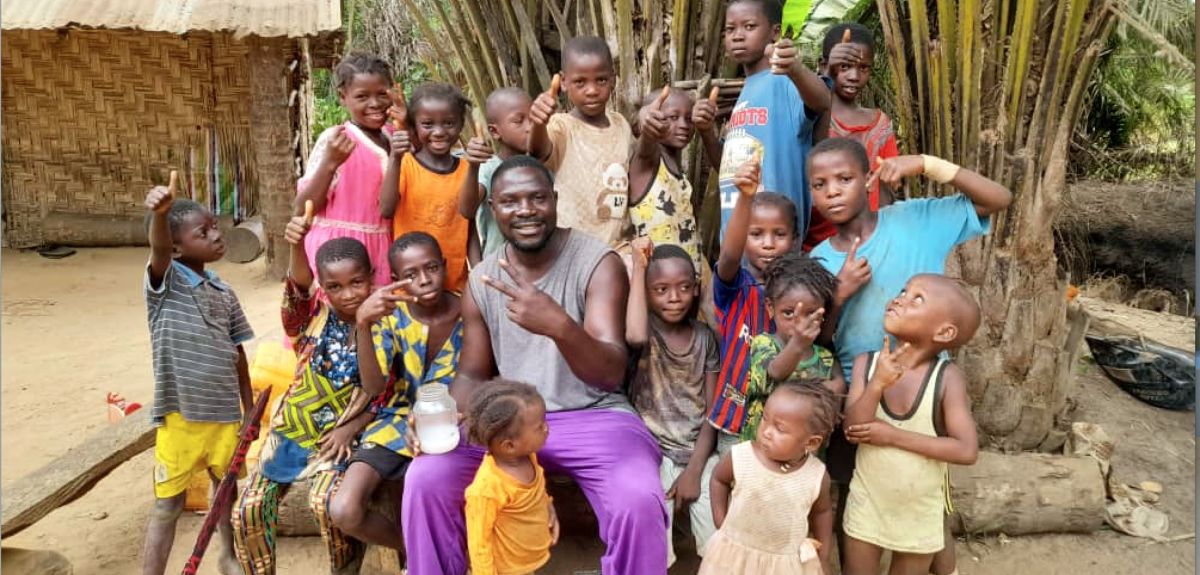
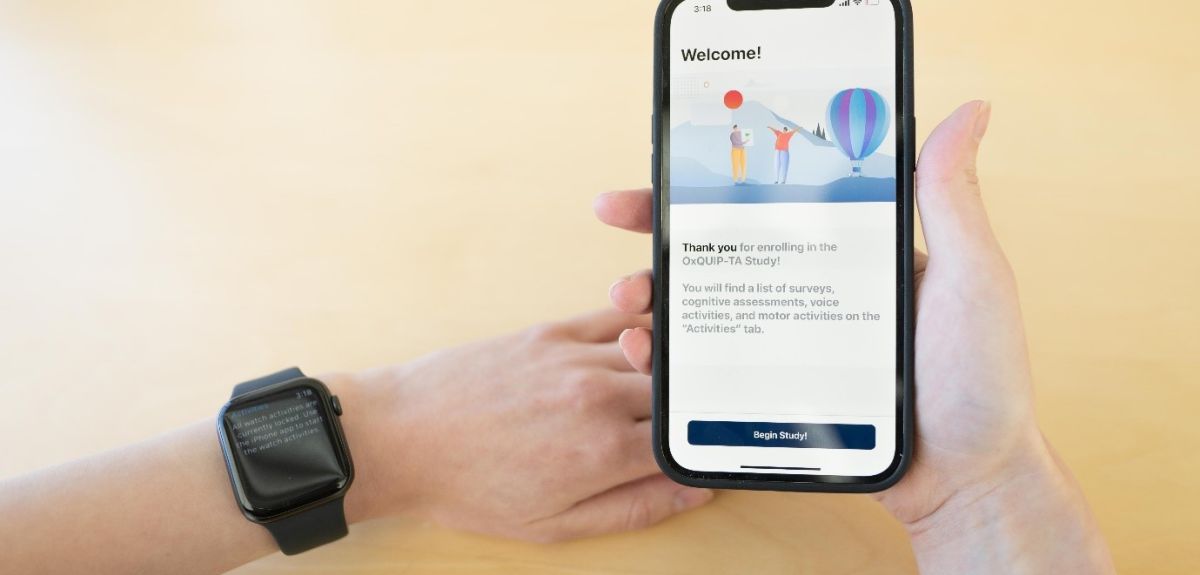
 A green fuels breakthrough: bio-engineering bacteria to become ‘hydrogen nanoreactors’
A green fuels breakthrough: bio-engineering bacteria to become ‘hydrogen nanoreactors’ Oxford's student voices at COP29
Oxford's student voices at COP29 Teaching the World’s Future Leaders
Teaching the World’s Future Leaders  A blueprint for sustainability: Building new circular battery economies to power the future
A blueprint for sustainability: Building new circular battery economies to power the future Oxford citizen science project helps improve detection of antibiotic resistance
Oxford citizen science project helps improve detection of antibiotic resistance The Oxford students at the forefront of the fight against microbial resistance
The Oxford students at the forefront of the fight against microbial resistance  The hidden cost of AI: In conversation with Professor Mark Graham
The hidden cost of AI: In conversation with Professor Mark Graham  Astrophoria Foundation Year: Dr Jo Begbie reflects on the programme’s first year
Astrophoria Foundation Year: Dr Jo Begbie reflects on the programme’s first year World Malaria Day 2024: an interview with Professor Philippe Guerin
World Malaria Day 2024: an interview with Professor Philippe Guerin